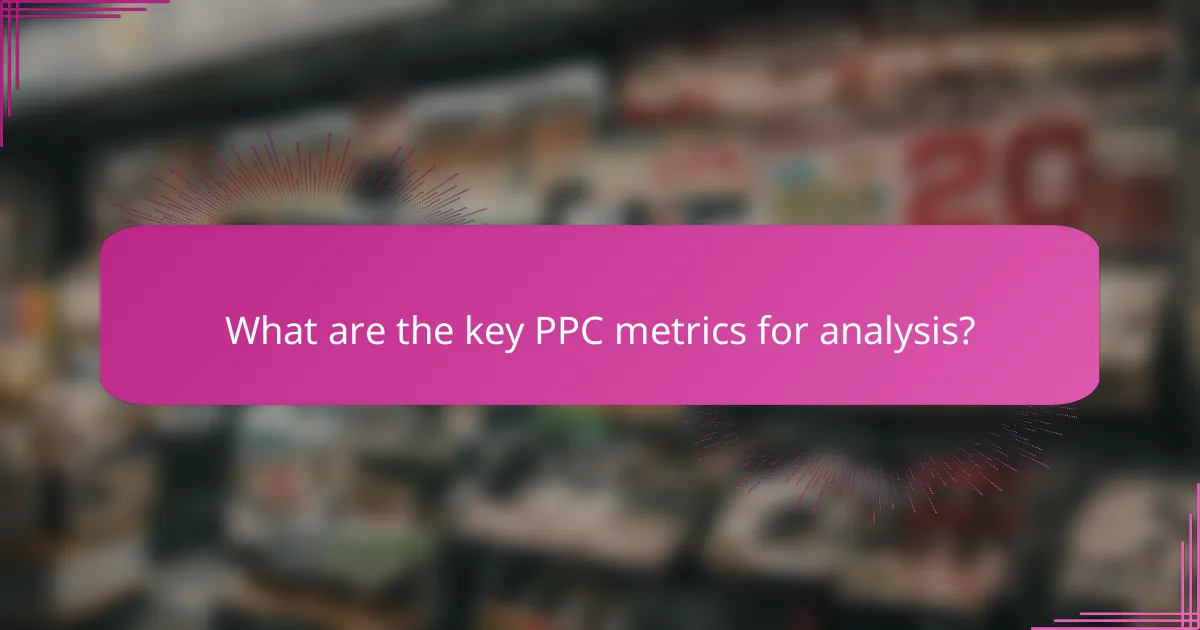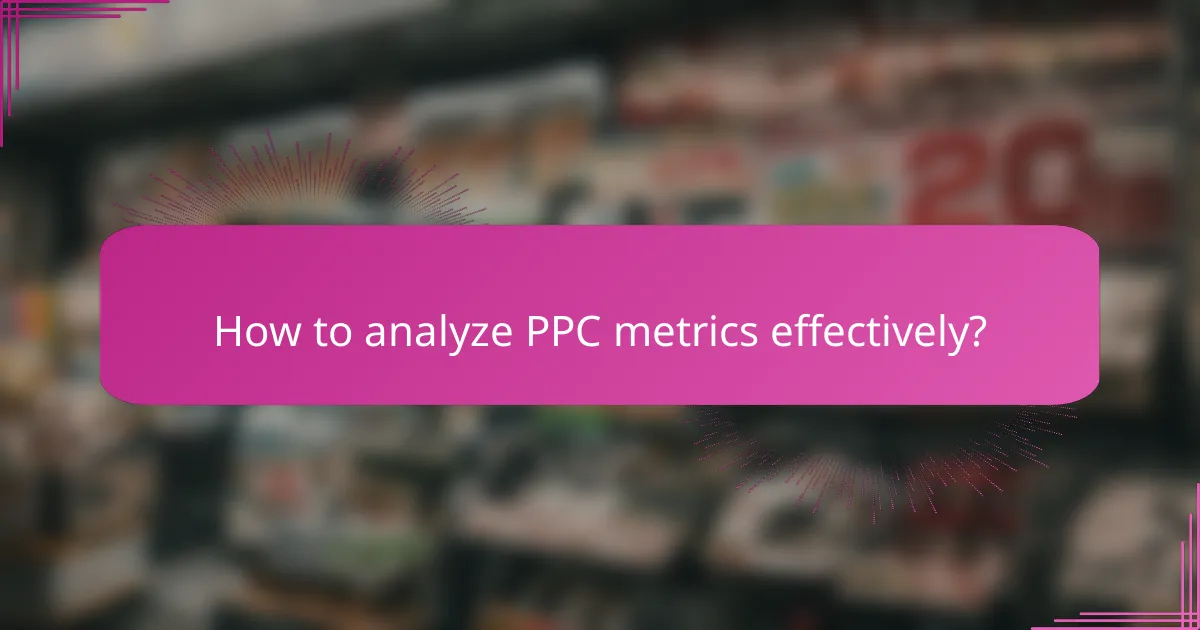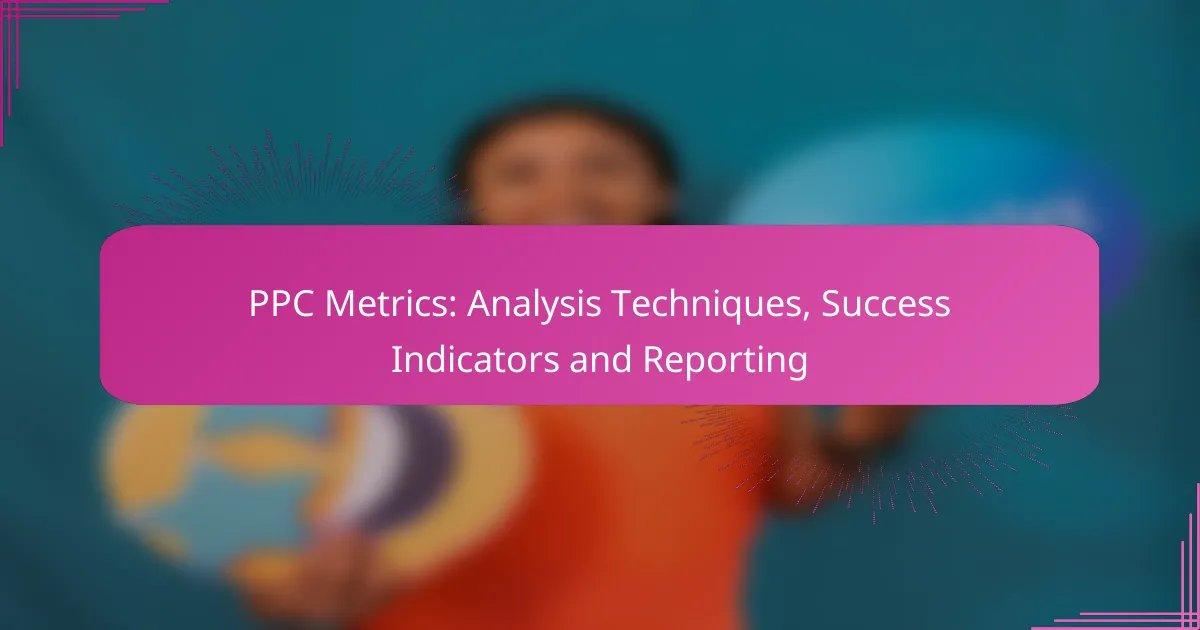In the realm of Pay-Per-Click (PPC) advertising, understanding key metrics is essential for evaluating campaign performance and driving effective strategies. Metrics such as Click-Through Rate (CTR), Conversion Rate, and Return on Ad Spend (ROAS) serve as critical indicators of success, guiding advertisers in making informed decisions. By focusing on these performance indicators, businesses can optimize their campaigns to achieve desired outcomes and enhance overall effectiveness.

What are the key PPC metrics for analysis?
The key PPC metrics for analysis include Click-Through Rate (CTR), Conversion Rate, Cost Per Click (CPC), Return on Ad Spend (ROAS), and Quality Score. Understanding these metrics helps advertisers evaluate campaign performance and make data-driven decisions to optimize their strategies.
Click-Through Rate (CTR)
Click-Through Rate (CTR) measures the percentage of users who click on an ad after seeing it. A higher CTR indicates that the ad is relevant and engaging to the target audience. Typically, a CTR of 2-5% is considered average, but this can vary by industry.
To improve CTR, focus on creating compelling ad copy and using targeted keywords. Avoid generic phrases; instead, tailor your message to address specific user needs and interests.
Conversion Rate
The Conversion Rate represents the percentage of clicks that result in a desired action, such as a purchase or sign-up. A good conversion rate usually falls between 2-5%, but this can differ based on the type of campaign and industry.
To enhance conversion rates, ensure your landing pages are optimized for user experience, with clear calls to action and relevant content. Regularly test different elements, such as headlines and images, to find what resonates best with your audience.
Cost Per Click (CPC)
Cost Per Click (CPC) is the amount paid for each click on an ad. This metric directly impacts your advertising budget and overall ROI. CPC can vary widely, often ranging from a few cents to several dollars, depending on competition and keyword popularity.
To manage CPC effectively, consider using negative keywords to filter out irrelevant traffic and adjust bids based on performance. Regularly review your campaigns to identify high-cost keywords that may need optimization.
Return on Ad Spend (ROAS)
Return on Ad Spend (ROAS) measures the revenue generated for every dollar spent on advertising. A ROAS of 4:1 is often viewed as a benchmark for success, meaning you earn four dollars for every dollar spent. However, acceptable ROAS can vary by business model.
To improve ROAS, focus on targeting high-value customers and refining your ad placements. Analyze which campaigns yield the best returns and allocate more budget to those efforts while scaling back on underperforming ads.
Quality Score
Quality Score is a metric used by platforms like Google Ads to assess the relevance and quality of your ads, keywords, and landing pages. A higher Quality Score can lead to lower CPC and better ad placements. Scores typically range from 1 to 10, with 7 or above being favorable.
To boost your Quality Score, ensure alignment between your ad copy, keywords, and landing page content. Regularly review and optimize your campaigns based on performance data to maintain high relevance and user satisfaction.

How to analyze PPC metrics effectively?
To analyze PPC metrics effectively, focus on key performance indicators (KPIs) that directly impact your campaign goals. Understanding metrics like click-through rate (CTR), conversion rate, and cost per acquisition (CPA) will help you assess performance and make informed adjustments.
Utilize Google Ads Reports
Google Ads provides a variety of reports that can help you analyze PPC metrics in detail. You can access performance reports by campaign, ad group, or keyword to identify which elements are driving results. Regularly reviewing these reports allows you to spot trends and optimize your strategy accordingly.
Consider focusing on metrics such as impression share and quality score, as these can significantly influence your ad visibility and costs. Utilize the built-in filters to narrow down your analysis to specific time frames or demographics for deeper insights.
Implement A/B Testing
A/B testing, or split testing, involves comparing two versions of an ad to determine which performs better. By changing one variable at a time, such as the ad copy or call-to-action, you can gain clear insights into what resonates with your audience. This method is essential for optimizing ad performance over time.
Start with small changes and run tests for a sufficient duration to gather meaningful data. Aim for a minimum of a few hundred clicks per variant to ensure statistical significance. Avoid making multiple changes at once, as this can complicate your analysis.
Leverage Analytics Tools
Using analytics tools like Google Analytics can enhance your PPC metric analysis by providing additional context about user behavior after they click your ads. Integrating Google Ads with Google Analytics allows you to track conversions and user engagement on your website.
Focus on metrics such as bounce rate and average session duration to understand how effectively your landing pages convert traffic. Set up goals in Google Analytics to measure specific actions, like sign-ups or purchases, which can help you assess the true ROI of your PPC campaigns.

What are the success indicators for PPC campaigns?
Success indicators for PPC campaigns include metrics that reflect the effectiveness of advertising efforts in achieving business goals. Key indicators often focus on sales volume, brand awareness, and customer engagement, providing insights into campaign performance and areas for improvement.
Increased Sales Volume
Increased sales volume is a primary success indicator for PPC campaigns, as it directly reflects the effectiveness of ads in driving revenue. Monitoring sales metrics can help determine which ads or keywords are most profitable, allowing for better allocation of budget and resources.
To assess sales volume, track conversions through tools like Google Analytics or conversion tracking pixels. A good benchmark is to aim for a conversion rate of around 2-5%, depending on the industry. Regularly analyze which campaigns yield the highest return on investment (ROI) to optimize future spending.
Improved Brand Awareness
Improved brand awareness indicates how well a PPC campaign is increasing visibility and recognition among target audiences. Metrics such as impressions, click-through rates (CTR), and brand search volume can provide insights into how effectively your ads are reaching potential customers.
To measure brand awareness, consider conducting surveys or using tools like Google Trends to analyze search interest over time. Aim for a CTR of at least 1-2% for display ads and higher for search ads, as this can signify effective engagement with your brand.
Higher Customer Engagement
Higher customer engagement is a crucial indicator of how well your PPC ads resonate with your audience. Engagement can be measured through metrics such as time spent on site, pages per session, and social media interactions resulting from ad clicks.
To enhance engagement, focus on creating compelling ad copy and landing pages that encourage interaction. A good practice is to aim for an average session duration of over two minutes and multiple pages viewed per visit. Regularly test different ad formats and messaging to see what drives the most engagement.

How to create effective PPC reports?
Effective PPC reports clearly communicate performance metrics and insights to stakeholders. They should focus on key performance indicators, use visual data representations, and summarize actionable insights and recommendations.
Define Key Performance Indicators (KPIs)
Key Performance Indicators (KPIs) are essential metrics that help measure the success of your PPC campaigns. Common KPIs include Click-Through Rate (CTR), Cost Per Click (CPC), Conversion Rate, and Return on Ad Spend (ROAS). Selecting the right KPIs depends on your campaign goals, whether they are brand awareness, lead generation, or sales.
When defining KPIs, ensure they align with your overall marketing objectives. For instance, if your goal is to drive sales, focus on metrics like conversion rate and ROAS. Regularly review and adjust your KPIs to reflect changes in strategy or market conditions.
Use Visual Data Representations
Visual data representations, such as charts and graphs, make complex data easier to understand. Use bar charts to compare performance across different campaigns or line graphs to show trends over time. This visual approach helps stakeholders quickly grasp the effectiveness of various strategies.
Consider using dashboards that allow for real-time data visualization. Tools like Google Data Studio or Tableau can help create interactive reports that highlight key metrics and trends, making it easier to spot areas for improvement.
Summarize Insights and Recommendations
Summarizing insights and recommendations is crucial for translating data into actionable strategies. After analyzing your KPIs, identify patterns or anomalies and provide clear recommendations based on your findings. For example, if a campaign has a low CTR, suggest testing new ad copy or targeting options.
Keep your summaries concise and focused on the most impactful insights. Use bullet points for clarity and ensure that recommendations are specific and achievable. This approach not only informs stakeholders but also drives informed decision-making for future campaigns.

What are common pitfalls in PPC metric analysis?
Common pitfalls in PPC metric analysis include misinterpreting data, focusing on vanity metrics, and neglecting the context of performance indicators. These mistakes can lead to misguided strategies and wasted budgets.
Misinterpreting data
Misinterpretation of data often occurs when metrics are viewed in isolation rather than in relation to each other. For instance, a high click-through rate (CTR) might seem positive, but if the conversion rate is low, it indicates that the traffic is not relevant. Always analyze metrics in conjunction to gain a clearer picture of campaign performance.
Another common error is failing to account for seasonality or external factors that may influence results. For example, a sudden drop in performance during holiday seasons could be misread as a failure of the campaign rather than a typical market trend.
Focusing on vanity metrics
Vanity metrics, such as impressions or clicks, can give a false sense of success without reflecting actual business outcomes. While these numbers can be impressive, they do not necessarily correlate with profitability or return on investment (ROI). Prioritize metrics that directly impact your goals, such as conversion rates and cost per acquisition (CPA).
To avoid this pitfall, establish clear objectives for your PPC campaigns and align your metrics with those goals. For example, if your aim is to increase sales, focus on revenue generated rather than just traffic numbers.
Neglecting the context of performance indicators
Context is crucial in PPC metric analysis. A metric may appear favorable on its own but could be misleading without understanding the broader landscape. For instance, a low CPA might seem beneficial, but if the quality of leads is poor, it may not justify the cost.
Always consider factors such as industry benchmarks and historical performance when evaluating metrics. Comparing your results to similar campaigns can provide valuable insights and help identify areas for improvement.
